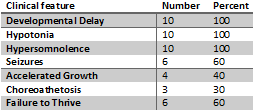GABA-Transaminase (GABA-T) deficiency is a multisystem disorder characterized by developmental delay, hypotonia, hypersomnolence, epilepsy, and choreoathetosis. Accelerated linear growth and failure to thrive are also characteristics. Children with GABA-transaminase deficiency have profoundly impaired development. The majority do not achieve normal developmental milestones of infancy, such as sitting unassisted. In the past, mortality within the first 2 years of life was reported. However, recent reports indicate survival into adolescence and adulthood.
Movement disorders may be very prominent when present, with choreoathetosis reported in one-third of patients. A combined presentation of hypersomnolence and hyperkinetic movement disorder of distal extremities during wakefulness, superimposed upon hypotonia and impaired response to auditory and visual stimuli has been described. Virtually constant choreoathetosis and myoclonus have been seen.
Table 1: Clinical Manifestations GABA- T (N=10) (Koenig et al. 2017)

Electroencephalography shows severe abnormalities including burst-suppression, modified hypsarrhythmia, multifocal spike discharges, generalized spike and wave, and diffuse background slowing and disorganization. Imaging has shown hypomyelination, T2- and diffusion weighted hyperintensities involving white matter including the internal and external capsules, and progressive cerebral atrophy.
